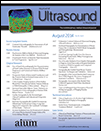Acoustic Radiation Force for Noninvasive Evaluation of Corneal Biomechanical Changes Induced by Cross-linking Therapy
Supported by the American Institute of Ultrasound in Medicine Endowment for Education and Research
Abstract
Objectives
To noninvasively measure changes in corneal biomechanical properties induced by ultraviolet-activated riboflavin cross-linking therapy using acoustic radiation force (ARF).
Methods
Cross-linking was performed on the right eyes of 6 rabbits, with the left eyes serving as controls. Acoustic radiation force was used to assess corneal stiffness before treatment and weekly for 4 weeks after treatment. Acoustic power levels were within US Food and Drug Administration guidelines for ophthalmic safety. Strain, determined from ARF-induced displacement of the front and back surfaces of the cornea, was fit to the Kelvin-Voigt model to determine the elastic modulus (E) and coefficient of viscosity (η). The stiffness factor, the ratio of E after treatment to E before treatment, was calculated for treated and control eyes. At the end of 4 weeks, ex vivo thermal shrinkage temperature analysis was performed for comparison with in vivo stiffness measurements. One-way analysis of variance and Student t tests were performed to test for differences in E, η, the stiffness factor, and corneal thickness.
Results
Biomechanical stiffening was immediately evident in cross-linking–treated corneas. At 4 weeks after treatment, treated corneas were 1.3 times stiffer and showed significant changes in E (P= .006) and η (P= .007), with no significant effect in controls. Corneal thickness increased immediately after treatment but did not differ significantly from the pretreatment value at 4 weeks.
Conclusions
Our findings demonstrate a statistically significant increase in stiffness in cross-linking–treated rabbit corneas based on in vivo axial stress/strain measurements obtained using ARF. The capacity to noninvasively monitor corneal stiffness offers the potential for clinical monitoring of cross-linking therapy.




